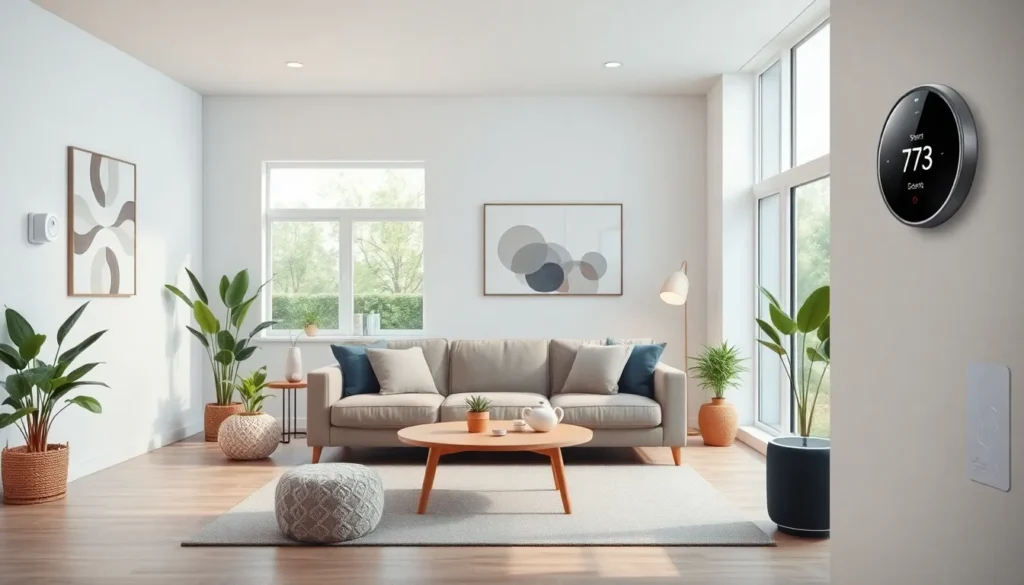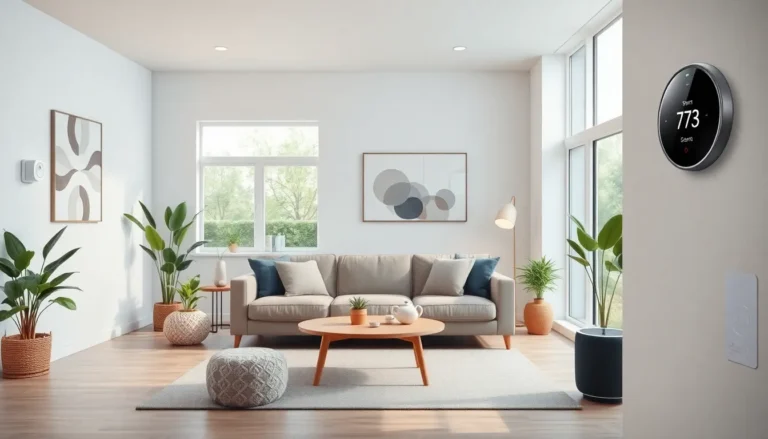Table of Contents
ToggleIn a world where fridges can remind you to buy milk and lights can turn on with a wave of your hand, home sensors are the unsung heroes of modern living. These nifty gadgets don’t just make life easier; they turn homes into smart havens that anticipate needs and respond to whims. Imagine a home that knows when you’re coming and going, adjusting the temperature and lighting just right—no more stumbling around in the dark like a confused zombie!
Overview of Home Sensors
Home sensors serve crucial functions in creating smart environments equipped for modern living. These devices monitor various elements, such as temperature, humidity, and motion, allowing homeowners to optimize their living spaces effortlessly. Smart thermostats, for instance, adjust heating and cooling based on occupancy patterns, contributing to energy savings.
Lighting sensors enhance safety and convenience. These sensors detect movement and automatically turn lights on or off, making navigation easier during the night. Likewise, security sensors, including door and window alarms, provide alerts for unauthorized access, ensuring peace of mind for residents.
Water leak sensors play a vital role in preventing property damage. Once a leak is detected, these devices send immediate alerts to homeowners, allowing prompt action to mitigate further issues. Smoke and carbon monoxide detectors protect against potential hazards by providing real-time alerts, enhancing household safety.
Integrating these sensors into home automation systems greatly increases their potential. For example, a smart home hub can centralize control, allowing homeowners to manage all sensors from one interface. Sensors can work together, optimizing energy efficiency and providing seamless automation.
Understanding the various types of home sensors and their functions aids in making informed choices for enhancing home efficiency. The practical applications of these sensors lead to a more comfortable living experience while ensuring safety and security.
Types of Home Sensors

Home sensors come in various types, each serving distinct functions. Identifying these types helps homeowners select the right devices for their needs.
Security Sensors
Security sensors play a vital role in residential safety. They include motion detectors and door/window sensors that detect unauthorized access. Some advanced systems utilize cameras to provide real-time monitoring. Security sensors send instant alerts to homeowners when suspicious activity occurs. Integration with smart home systems allows for remote monitoring and control. Real-time notifications empower homeowners to take immediate action if needed.
Environmental Sensors
Environmental sensors focus on monitoring indoor conditions. Temperature sensors regulate heating and cooling systems to maintain comfort levels. Humidity sensors detect moisture levels, preventing mold growth and enhancing air quality. Water leak sensors provide timely alerts to avert potential flooding. These devices contribute to energy efficiency and improve overall living conditions. Environmental sensors adapt settings based on preferences, making homes more comfortable and inviting.
Smart Home Sensors
Smart home sensors enhance automation and connectivity. They include smart thermostats, lighting controls, and appliances that communicate with each other. These devices optimize energy consumption based on usage patterns. Homeowners can customize settings remotely via apps or voice commands. Smart home sensors enhance daily convenience and simplify home management. Their integration into a broader home automation ecosystem allows for seamless operation.
Benefits of Home Sensors
Home sensors offer significant advantages that enhance daily living. These innovative devices provide increased security, energy efficiency, and convenience.
Enhanced Safety and Security
Home sensors play a crucial role in safeguarding residential spaces. Motion detectors alert residents to movement, enabling immediate response to any potential threats. Door and window sensors notify homeowners when entry points are compromised. These features promote peace of mind and increase safety levels. Security systems that incorporate cameras enhance monitoring capabilities, allowing for real-time video feeds. Additionally, smart alarm systems integrate with sensors, sending alerts directly to smartphones during emergencies. The combination of these technologies creates a comprehensive safety network within the home.
Energy Efficiency
Energy efficiency improves as home sensors automatically adjust settings based on occupancy. Smart thermostats optimize heating and cooling, responding to the presence of people in specific rooms. Consequently, energy waste decreases, leading to reduced utility bills. Lighting sensors detect ambient light levels, ensuring exterior and interior lights operate only as needed. Homeowners experience significant savings through energy-efficient practices enhanced by sensor technology. Furthermore, these sensors contribute to environmental sustainability by reducing carbon footprints associated with energy consumption.
Convenience and Automation
Convenience increases through the automation capabilities of home sensors. Homeowners manage lighting, temperature, and security remotely via smartphone applications. Customizable settings allow individuals to tailor environments according to their preferences. Motion sensors activate lights when someone enters a room, ensuring visibility without manual effort. Voice-activated assistants can also control sensors within smart homes, making daily tasks seamless. The integration of these systems transforms ordinary homes into sophisticated living spaces, improving lifestyle quality.
Installation and Setup
Setting up home sensors involves strategic planning and precise execution. Efficient installation ensures optimal performance and ease of use.
Choosing the Right Sensors
Selecting the appropriate sensors is crucial for effective home automation. Assess specific needs, like security, environmental monitoring, or energy management. Research options such as motion detectors for security and temperature sensors for climate control. Evaluate compatibility with existing systems to avoid integration issues. Prioritize features based on personal lifestyle and preferences. For example, smart lighting sensors may be ideal for energy-saving initiatives, while water leak detectors are essential for preventing damage. Homeowners should also consider brands known for reliability and customer support.
DIY vs Professional Installation
Determining between DIY and professional installation requires careful consideration. Many homeowners opt for DIY installation due to cost-effectiveness and simplicity. Typical sensor installations, like smart doorbells, can often be completed in under an hour with basic tools. However, complex setups may necessitate the expertise of professionals, ensuring the sensors function correctly and maintain warranty guidelines. Professional services often provide additional support, including system integration and troubleshooting assistance. Weighing the advantages of professional guidance against the benefits of self-installation can help homeowners make an informed choice.
Home sensors are revolutionizing the way people interact with their living spaces. By providing enhanced safety energy efficiency and convenience they empower homeowners to create smart environments that cater to their needs. The seamless integration of various sensor types not only improves daily life but also offers peace of mind through real-time alerts and automation.
As technology continues to advance the potential of home sensors will only grow. Homeowners who embrace these innovations stand to benefit from a more efficient comfortable and secure lifestyle. With careful planning and informed choices they can transform their homes into sophisticated smart havens that enhance their overall quality of life.







